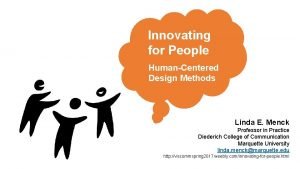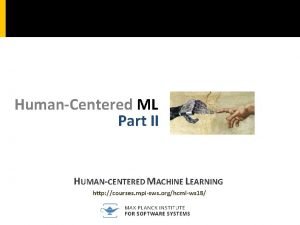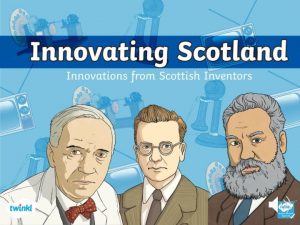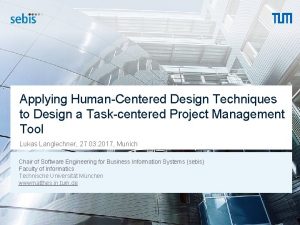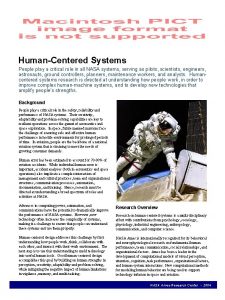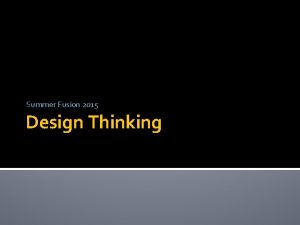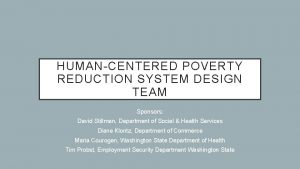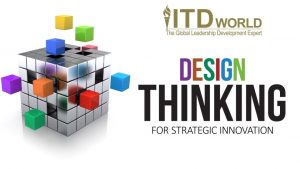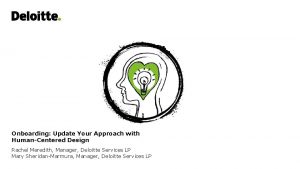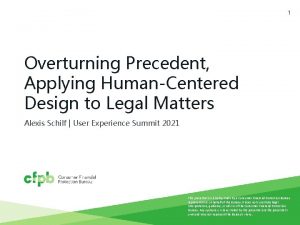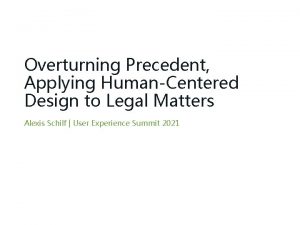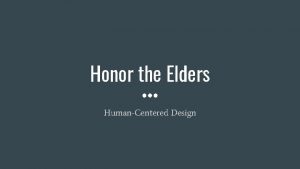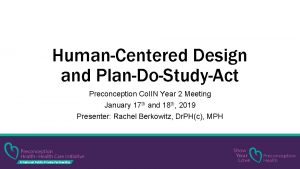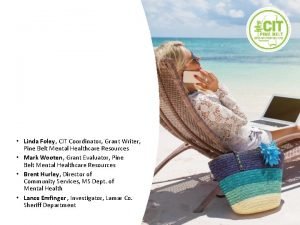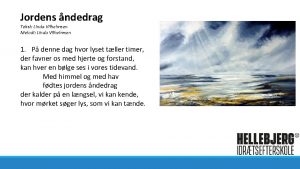Innovating for People HumanCentered Design Methods Linda E































- Slides: 31

Innovating for People Human-Centered Design Methods Linda E. Menck Professor in Practice Diederich College of Communication Marquette University linda. menck@marquette. edu http: //viscommspring 2017. weebly. com/innovating-for-people. html

“Everyone designs who devises courses of action aimed at changing existing situations into preferred ones. ” Herbert Simon Nobel Laureate in Economics Inventor and designer of electrical control gear, and patent attorney. An active leader in professional and civic affairs, who received an honorary doctorate from Marquette University for his many activities in the community.


Human-Centered Design Human-centered design is a creative approach to problem solving. It's a process that starts with the people you're designing for and ends with new solutions that are tailor made to suit their needs. It’s about innovating for people and discovering unmet or unfulfilled needs.

LOOKING Observing Human Experience Innovation begins and ends with people. It calls for keen and caring observation. The disciplined practice of human-centered design involves careful investigation. It requires curiosity, objectivity, and empathy. You need to engage all of your senses (looking, listening, and so forth) in pursuit of meaningful and valuable findings.

UNDERSTANDING Analyzing Challenges & Opportunities Innovation is not a “lightbulb” moment of genius. It calls for deep understanding and rigorous discernment. The disciplined practice of human-centered design involves thoughtful analysis. It requires critical thinking, problem framing, and making connections. You need to identify patterns, determine priorities, and translate your research into actionable insights.

MAKING Envisioning Future Possibilities Innovation puts great ideas into action. It calls for making things happen in a resourceful and resonant manner. The disciplined practice of human-centered design involves imaginative visual expression. It requires a commitment to successive improvement through frequent iteration. You need to think with your hands to bring new ideas to life.

LOOKING Research Methods for Observing Human Experience ethnographic participatory evaluative

Ethnographic Research In ethnography, research is conducted in the field, where users’ real-world behaviors and interactions with products and services take place, so that researchers can gain insight into how context impacts user experiences. Stepping out of your native environment to learn what people do in places they inhabit is a great way to discover opportunities for innovation. Ethnographic research methods are good for studying human behavior in its natural setting. Ethnography is a branch of Anthropology.

The Anthropologists The Anthropologist is rarely stationary. Rather, this is the person who ventures into the field to observe how people interact with products, services, and experiences in order to come up with new innovations. The Anthropologist is extremely good at reframing a problem in a new way, humanizing the scientific method to apply it to daily life. Anthropologists share such distinguishing characteristics as the wisdom to observe with a truly open mind; empathy; intuition; the ability to "see" things that have gone unnoticed; a tendency to keep running lists of innovative concepts worth emulating and problems that need solving; and a way of seeking inspiration in unusual places.

Ethnographic research offers several key benefits: • Identifying user needs that have yet to be met. • Testing market demand for products that do not exist. • Providing a holistic view of a problem space. • Exposing opportunities for competitive differentiation. The principal advantage of ethnographic methods is the ability to see the impact of the physical world on factors that could drive design and innovation. Ethnographic research is all about discovery of the unknown – disproving assumptions about user behavior and uncovering unexpected insights.

ethnography Empathy is at the heart of design. Without the understanding of what others see, feel, and experience, design is a pointless task. When communicated as it is in this video created by Delos Cosgrove for the Cleveland Clinic, empathy can be truly inspirational. What the Cleveland Clinic video reveals is the true scale and complexity of the challenge of understanding a complex social situation in order to design a system that supports many and various needs.

Think of this movie as a design brief. How would you design a hospital or health care system that helps and supports each of the people and their circumstances that you see here? How would you change the space, the roles that staff play, the type and manner in which patients receive information, the support systems around patients and staff?

Ethnographic Research Methods • Interviewing • Fly-on-the-Wall Observation • Contextual Inquiry • Walk-a-Mile Immersion

Interviewing A technique for gathering information through direct dialogue People generally enjoy telling stories about their experiences. A good interview helps you take advantage of this natural inclination in order to gather valuable information. Interviewing gives you an opportunity to speak directly with the people who can help you make informed decisions. Through these interviews you gain a better sense of people and their views of the world by subtly eliciting their true feelings, realities, desires, struggles, and opinions through a few carefully crafted questions. An additional sensitivity to the unplanned and unscripted aspects of an interview can allow for equally illuminating discoveries. A good interviewer needs to be attuned to the interviewee to know when to probe for more information, when to redirect the conversation, and how to parse what is meant from what is said.

Interviewing Benefits • Helps you gain information directly. • Challenges your preconceptions or biases. • Deepens your empathy for others. • Builds credibility with stakeholders.

Interviewing Quick Guide • Identify a topic for investigation. • Prepare your questions and recording equipment (with permission). • Determine your criteria for selecting interviewees. • Identify the people you will interview. • Set a time and place to meet them. • Introduce yourself and the purpose. Obtain consent. • Start with “easy” questions, then draw out specifics. • LISTEN CAREFULLY and take good notes. • Thank each participant.

Interviewing Helpful Hints • Try to choose a location with minimal distractions. • Don’t put words into the interviewee’s mouth • Resist the urge to conduct an analysis at this stage.

Fly-on-the-Wall Observation An approach to conducting field research in an unobtrusive manner Minimizing your impact can be a great way to maximize your discoveries. In situations where you can’t speak directly with people, or don’t want to interrupt the flow of their activities, being a fly on the wall has its advantages. You’ll come to find that careful, unobtrusive observation provides valuable insight you can’t otherwise obtain. When left to their own devices, people are likely to say or do thigs that they’re not aware of and would not be able to articulate, even if prompted. If you can watch and listen without interfering, you have a chance to capture people’s natural behavior. Remember to pay careful attention to people’s tasks and workflow, taking note of the information, tools, and people they rely upon to do what they do. Also be mindful of the surrounding environment, understanding that peripheral objects, sounds, and people may affect outcomes.

Fly-on-the-Wall Observation Benefits • Diminishes your presence as a researcher. • Deepens your empathy for others. • Challenges your assumptions. • Informs subsequent research activities.

Fly-on-the-Wall Observation Quick Guide • Identify a subject area to study. • Develop a plan to guide your investigation. • Consider which people and activities to watch. • Chose a location to visit. • Obtain the necessary access and permission(s). • Always be legal and ethical. • Prepare materials for capturing what you see. • Go out and observe. • Record your findings in video, photos, and notes (with permission).

Fly-on-the-Wall Observation Helpful Hints • Make every effort to blend in to the background. Wear a “cloak of invisibility. ” • Take on the role of an objective bystander. • Look at the situation from several vantage points. • Use all your senses.

Contextual Inquiry An approach to interviewing and observing people in their environment “What people say, what people do, and what they say they do are entirely different things, ” observes influential anthropologist Margaret Mead. Following this wisdom, it is crucial that we pay attention to what people say and what people do in order to get a clear picture of what really happens. A Contextual Inquiry places you in the midst of a person’s environment where you can inquire about his or her experiences in context as they are happening. Consequently, input comes directly from the people who have the most knowledge, saving you from making assumptions about how and why things are done. Even when you do have some background knowledge of a person’s role or situation, it helps to approach as a novice or to think of yourself as an apprentice. At the same time, bear in mind that you are trying to gather useful information for a specific purpose, so keep the design challenge in view as you interact with participants.

Contextual Inquiry Benefits • Reveals what people actually do and say. • Deepens your empathy for others. • Challenges your assumptions. • Builds credibility with stakeholders.

Contextual Inquiry Quick Guide • Identify a location and the people to be involved. • Prepare your questions and recording equipment (with permission). • Go to the site. • Introduce yourself and the purpose. Obtain consent. • Ask the participants to ”show and tell” about tasks in a normal way. • Observe their actions in an unobtrusive manner. • Interject questions at opportune moments. Ask WHY. • Record your finds in videos, photos, and notes (with permission). • Thank each participant.

Contextual Inquiry Helpful Hints • Ask people to do activities, not just give you a tour. • Use more than one researcher to get multiple views. • Stay focused on your goals, yet open to discovery.

Walk-a-Mile Immersion A way of building empathy for people through firsthand experience As Atticus Finch teaches us in To Kill a Mockingbird, “You never really understand a person until you consider things from his point of view – until you climb into his skin and walk around in it. ” While any research method can help you better understand people and their needs, Walk-a-Mile forces you to take a person’s journey and experience their joys, conflicts, and weariness. In other words, you must not only see, but also feel what it’s like to live in the world as someone else. Practically speaking, this could mean any number of things: donning the equipment someone uses and performing a task, artificially altering one ore more of your senses, foregoing (or perhaps experiencing) some of life’s luxuries, or even living among people of a different society. Whatever the extent, the idea is to deepen your empathy for others, and to use that experience to better inform your decision making. If you can begin to understand people’s motivations, you will better understand their needs.

Walk-a-Mile Immersion Benefits • Helps you gain firsthand knowledge. • Deepens your empathy for others. • Fosters an attitude of humility. • Informs subsequent research activities.

Walk-a-Mile Immersion Quick Guide • Identify whose experience you want to replicate. • Choose the tasks and activities you will perform. • Assemble what is needed to run a simulation. • Determine the best location. • Obtain the necessary access and permission(s). • Always be legal, ethical, and sensitive. • Conduct the targeted tasks. • Do each activity as realistically as possible. • Note your findings along the way.

Walk-a-Mile Immersion Helpful Hints • Commit to the activity fully. Don’t give up early. • Ask another observer to help you capture findings. • Use an “empathy suit” to simulate human conditions.

Empathy Mapping Good design is grounded in a deep understanding of the person for whom you are designing. Designers have many techniques for developing this sort of empathy. An Empathy Map is one tool to help you synthesize your observations and draw out unexpected insights.
 Innovating for people
Innovating for people Wax pattern fabrication
Wax pattern fabrication Kontinuitetshantering i praktiken
Kontinuitetshantering i praktiken Typiska drag för en novell
Typiska drag för en novell Tack för att ni lyssnade bild
Tack för att ni lyssnade bild Returpilarna
Returpilarna Varför kallas perioden 1918-1939 för mellankrigstiden?
Varför kallas perioden 1918-1939 för mellankrigstiden? En lathund för arbete med kontinuitetshantering
En lathund för arbete med kontinuitetshantering Kassaregister ideell förening
Kassaregister ideell förening Tidbok yrkesförare
Tidbok yrkesförare Anatomi organ reproduksi
Anatomi organ reproduksi Förklara densitet för barn
Förklara densitet för barn Datorkunskap för nybörjare
Datorkunskap för nybörjare Tack för att ni lyssnade bild
Tack för att ni lyssnade bild Debattinlägg mall
Debattinlägg mall Delegerande ledarstil
Delegerande ledarstil Nyckelkompetenser för livslångt lärande
Nyckelkompetenser för livslångt lärande Påbyggnader för flakfordon
Påbyggnader för flakfordon Kraft per area
Kraft per area Offentlig förvaltning
Offentlig förvaltning I gullregnens månad
I gullregnens månad Presentera för publik crossboss
Presentera för publik crossboss Vad är ett minoritetsspråk
Vad är ett minoritetsspråk Kanaans land
Kanaans land Klassificeringsstruktur för kommunala verksamheter
Klassificeringsstruktur för kommunala verksamheter Epiteltyper
Epiteltyper Claes martinsson
Claes martinsson Cks
Cks Programskede byggprocessen
Programskede byggprocessen Bra mat för unga idrottare
Bra mat för unga idrottare Verktyg för automatisering av utbetalningar
Verktyg för automatisering av utbetalningar Rutin för avvikelsehantering
Rutin för avvikelsehantering
